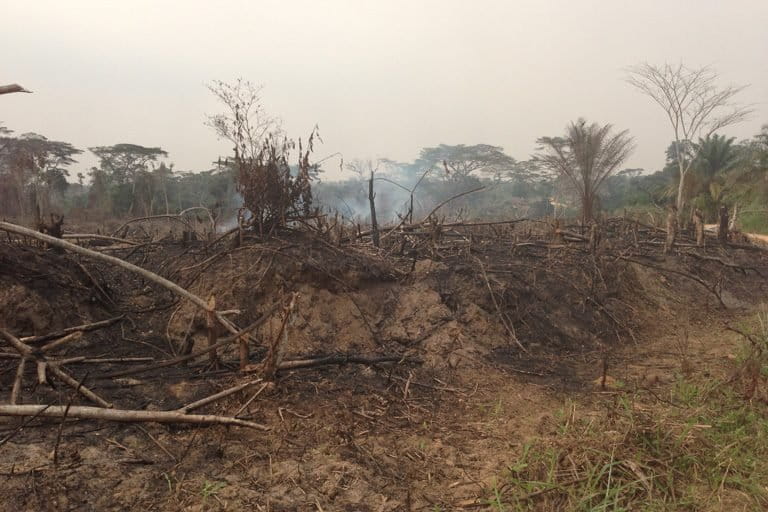- Tropical deforestation results in the release of not only carbon dioxide but also methane and nitrous oxide, leading to greater-than-anticipated warming of the global climate.
- The study compared emissions from land conversion with those from burning fossil fuels for energy and other sources.
- The researchers found that tropical deforestation at current rates could cause a 1.5-degree Celsius rise in global temperatures by 2100.
Scientists know that the carbon released by large-scale deforestation in the tropics inevitably helps boost global temperatures. Now, new research indicates that this conversion of land, often to farms and ranches to produce food for people, has a bigger impact on the climate than anticipated.
“Normally people only think about what’s happening right now when they think about the carbon budget,” said Natalie Mahowald, a climatologist at Cornell University and lead author of the study, in a statement. “But if you think about what’s going to happen over the lifetime of that land, long into the future, you should multiply that land conversion by two to understand the net effect of it.”

Only about 20 percent of the carbon dioxide that’s been added to the atmosphere comes from clearing forests. But this “land use and land cover change” is responsible for 40 percent of the warming of the planet. In part, that’s because carbon isn’t the only climate-warming culprit that these spots continue to emit. The research, published online in August by the journal Environmental Research Letters, demonstrates the lingering impact of the accompanying release of methane and nitrous oxide from deforested land.
One of the goals laid out in the Paris climate accord signed in 2015 is to keep the global temperature rise to under 2 degrees Celsius by the end of this century. Much of the current effort to meet this goal involves cutting the use of carbon-based fossil fuels in favor of sustainable alternatives. Mahowald and her colleagues agree with that approach, writing that curbing emissions from these sources of energy should be “the primary target.”
“It’s an incredibly important step to take, but, ironically, particulates released from the burning of fossil fuels — which are severely detrimental to human health — have a cooling effect on the climate,” she said. “Removing those particulates actually makes it harder to reach the lower temperatures laid out in the Paris agreement.”
That complication points to the need to combat climate change by dealing with the often-underestimated consequences of deforestation.

Earlier this year, Mahowald and her team confirmed that losing forests, which serve as storehouses of carbon, compounds the effects on climate from these sorts of land-use decisions. In the current study, the team modeled how the global temperature will change based on current rates of deforestation in the tropics. They then compared these findings with temperature changes that would occur only as a result of other sources of carbon emissions, the bulk of which come from burning fossil fuels to generate energy.
The results don’t bode well for our ability to meet climate targets. Continued deforestation at the rates we’re seeing today will likely lead to a 1.5-degree-Celsius increase over what temperatures were before the Industrial Revolution by 2100. In fact, they found that such a temperature bump would likely occur even if we had slashed all other sources of emissions back in 2015, the researchers found.

This scenario could lead to a higher risk of extreme weather, declines in crop yields and more droughts. But those dangers would increase substantially if we let temperatures creep up to 2 degrees over pre-industrial levels, according to several scientists in the journal Nature Climate Change.
Mahowald and her colleagues conclude that policies aimed at tackling climate change should address deforestation as a major source of carbon, especially as demand for larger areas of land for food production increases in the tropics. In particular, policies should be focused on the long term, taking into account what Mahowald calls the “multi-centennial legacy of current land-use decisions.”
“When we think about climate change, we can’t stop at the end of the century,” she said in the statement. “The consequences keep going for a couple more centuries.”
CITATIONS:
Mahowald, N. M., Randerson, J. T., Lindsay, K., Munoz, E., Doney, S. C., Lawrence, P., … & Hoffman, F. M. (2017). Interactions between land use change and carbon cycle feedbacks. Global Biogeochemical Cycles, 31(1), 96-113.
Mahowald, N. M., Ward, D., Doney, S., Hess, P., & Randerson, J. T. (2017). Are the impacts of land use on warming underestimated in climate policy? Environmental Research Letters.
Mitchell, D., James, R., Forster, P. M., Betts, R. A., Shiogama, H., & Allen, M. (2016). Realizing the impacts of a 1.5 [deg] C warmer world. Nature Climate Change, 6(8), 735-737.
Banner image of deforestation in Malaysian Borneo by Rhett A. Butler / Mongabay.
FEEDBACK: Use this form to send a message to the author of this post. If you want to post a public comment, you can do that at the bottom of the page.
Follow John Cannon on Twitter: @johnccannon
